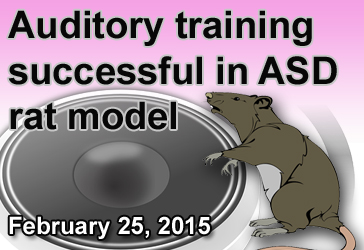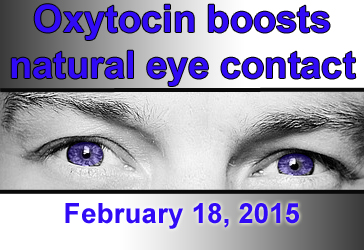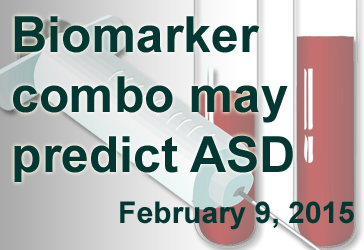Archives
February, 2015
Select a different month in the archive
Behavioral Training May Normalize Brain Dysfunction
By Chelsea E. Toledo, M.A. on February 25, 2015

Background: Research suggests that both genetic and environmental factors play a role in the development of autism spectrum disorder (ASD), which is characterized by differences in brain function and behavior. Multiple studies have pointed to antidepressants as a possible environmental factor, proposing that exposure to the drugs in the weeks before and after birth could induce ASD symptoms in children. In some animal models of autism, researchers expose rats to antidepressants to mimic the behavioral effects seen in children.
What’s new: On February 2, 2015, the journal Proceedings of the National Academy of Sciences published a study examining the effects of behavioral training on rats exposed to antidepressants shortly after birth. The researchers found that the rats behaved similarly to children with ASD—preferring to play alone than with other rats, for example. Using a set of sounds shown to drive changes in the brain in typically developing animals, the researchers observed that, at first, rats exposed to antidepressants scored poorly on cognitive tests—and had underlying brain dysfunction. Over the course of two months—the rough equivalent of two years for people—the rats continued the auditory training and showed significant improvement in their behavioral responses and some reversal of their brain dysfunction, as well.
Why it’s important: The effect of antidepressant exposure affected male rats much more than females—a pattern that mirrors the prevalence of ASD in the human population, in which boys are four times more likely than girls to receive a diagnosis. The study also positions behavioral training that targets brain function as a possible therapy for children with ASD.
Help me understand :
| Source(s) : |
| Tweet |
Oxytocin Improves Eye Contact
By Sharmila Banerjee-Basu, Ph.D. on February 18, 2015

Background: Oxytocin is a hormone produced in the brain with diverse physiological functions: labor contractions during childbirth, lactation, and sexual intimacy. More recently, scientists have examined oxytocin’s role in mediating social behaviors across mammalian species, including human. At present, oxytocin is an attractive pharmaceutical candidate for disorders of social cognition such as autism spectrum disorder (ASD).
What’s new: In a study published online, February 10, 2015, in the journal Molecular Psychiatry, scientists at University of Cambridge, UK, reported the effect of oxytocin in improving eye contact in a real-word social situation in adults with autism. The researchers administered an intranasal spray consisting of either oxytocin or placebo (same formulation without oxytocin), in a double-blinded manner, to 32 adult males with ASD and 34 neurotypical control participants. A novel test for social interaction – recording eye movements in a naturalistic setting – indicated that oxytocin significantly improved eye contact in both the ASD and control population. Importantly, oxytocin had a greater effect on looking time in ASD individuals with poor eye contact than in the placebo condition.
Why it’s important: Ongoing clinical trials are testing if therapeutic oxytocin can alleviate social cognition difficulties in children and young adults with ASD. This is the first study to show improvement of a core behavioral component of autism: eye contact in a social situation.
Help me understand :
| Source(s) : |
| Tweet |
Researchers Probe Blood Biomarkers for ASD
By Chelsea E. Toledo, M.A. on February 9, 2015

Background: At present, the only way to diagnose autism spectrum disorder (ASD) is through a series of behavioral screenings administered by trained professionals. While no laboratory test for ASD is currently available, recent studies have suggested that certain features detected in the blood could prove reliable as biomarkers for the disorder.
What’s new: The January 2015 issue of Neuroscience included a study evaluating two components in blood, serotonin and interleukin-6, as biomarkers for detecting ASD. While serotonin helps to regulate mood, interleukin-6 plays a role in the body’s inflammatory response to invading pathogens. The researchers performed blood tests on a total of 66 individuals—35 with ASD and 31 with typical development—whose average age was 12. They found that levels of serotonin and interleukin-6 were significantly elevated in the individuals with ASD, and were highest in those with the most severe forms of the disorder.
Why it’s important: The study found that, when taken together, serotonin and interleukin-6 were very reliable biomarkers for ASD—as blood tests looking for both molecules were accurate nearly 90 percent of the time. This work could lead to a clinical blood test for ASD risk, and could point the way to treatments targeting serotonin and interleukin-6.
Help me understand :
| Source(s) : |
| Tweet |

